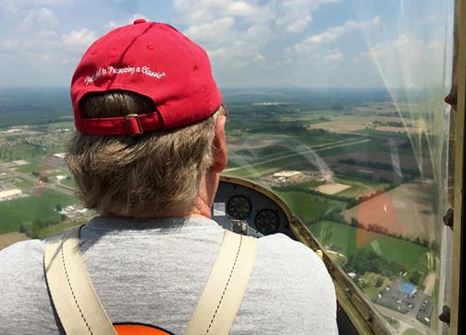I spent a couple of hours on Thursday in the skies over Ionia in the mighty SGS 2-33A with Lee Larder. Seven flights. I think that I’m becoming comfortable in the back seat. It’s a constant struggle to keep the tow plane above the cowl on the climb (especially when the tow plane hits sink and tries to disappear), but I’m not going to add a cushion to the seat now because I’d have to get used to a new sight picture and new muscle and inertial memory. And, as much easier as the whole thing is in the front seat, I don’t think I’d fly the ride from the front even if I had the option.
Still, I’m constantly put in mind of the Mike Meyers bit from So I Married an Axe Murderer:
We started with a tow to 2,500 to demonstrate all of the high airwork. Naturally, the dive brakes became jammed with a mixture of ice and extraterrestrial fauna, so I flew it sideways to that landing, happy with my slip and the control on the roll-out.
Next came what I had in mind for most of the flights of the day. I’ve long been a little worried about my ability to land the glider precisely. It’s always reasonably safe, but it doesn’t always come to rest on the runway where I want it to. So we did five pattern tows to try to dial in the precision of my landings. We set up a pair of cones along the runway edge about 400 feet apart, with the idea of touching down after the first one, but coming to a stop before the second one.
The first touchdown was a little short and the second one rolled out a little long, but I was generally happy with things. I had been avoiding slamming on wheel brake out of some aesthetic sense, but Lee suggested that I throw elegance to the wind if it looked like I had too much energy in the rollout. After all, it’s an emergency maneuver and you should expect a little brute force. And, as long as the wingtips are well off the ground and you don’t have a substantial side load, there’s little chance of a ground loop. So, if the second cone appears to be advancing too quickly, I’m going to be full-on the wheel brake and I can also let the stick come forward to dump a little more weight on the skid to get it stopped.
Otherwise, I’m doing things like a real CFI candidate. Get stabilized at 60 mph in the middle of the approach cone with half to three-quarters dive brakes. Get that aim point 200 feet short of the first cone (and on the other side of Lee’s head) to hold still in the windshield. Then flare and use the rest of the dive brakes once I have the first cone made. Then throw out the anchor and hope really hard.
The last flight was a 180 abort from 200 AGL. Lee pulled the clown nose at or above 200 AGL (and after my callout) and I know that the altimeter was correct, but we sure looked low at the 135-degree point in the turn back. As a TG-7A driver, I push pretty hard and pretty long for airspeed on a 180 abort because the TG-7A is a draggy beast that loses energy prodigiously when the thrust quits. The 2033A soesn’t slow down as quickly, so waited too long to bank for the turn. I need to get the turn going sooner next time. But we made it back with no problem and I even managed to retain the right amount of energy to get it back to the start point and even taxied off to the side using rudder so there wasn’t as far to push back.
 At the conclusion of flying, Lee and I went through the items I missed on the FOI and FIG knowledge tests, then he signed me off. My IACRA application had already been in for a day, so I gave him the application number and FRN so that he could approve it. And I left with all of the required endorsements in my logboog.
At the conclusion of flying, Lee and I went through the items I missed on the FOI and FIG knowledge tests, then he signed me off. My IACRA application had already been in for a day, so I gave him the application number and FRN so that he could approve it. And I left with all of the required endorsements in my logboog.
So it’s on the the ride! With CAP NLOC in Atlanta coming up June 10-14 and the River Days airshow June 19-21, I’m probably going to have to do the ride this coming week or push it until after the airshow. And, if I push it, I’ll probably fly one more time with Lee before the ride. I called Carol Dehnbostl (an FIE in the West Michigan FSDO and one of the main reasons that I went to Ionia to train) and I expect to hear back from her on Monday.



Your map overlays are epic. How do you overlay .GPx or .kml files that show track and altitude?
I record flights using ForeFlight on the iPad. After recording, I head to the Other page, select Track Logs, and then the upload button. The iPad will prompt you to “Open In . . .” If you have Google Earch loaded, it will be one of the options. Once you have the track log on the map, just move it around until the screen shows a view that you like. Do a screen capture and enjoy!